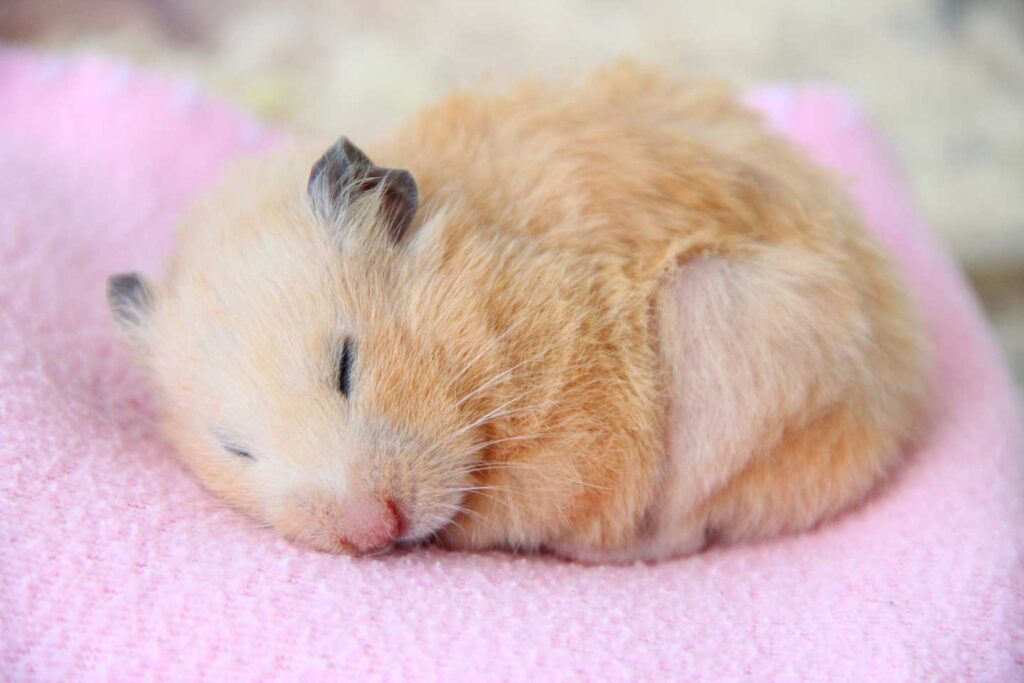Do Hamsters Hibernate?

Photo by Alex Milan/iStock/Getty Images Plus
Do hamsters hibernate? If you notice that your hamster is sleeping more than usual, it could be a sign of torpor, a hibernation-like state they can experience.
We talked with vets to learn more about hibernation vs. torpor in hamsters, including why it happens, what to do if your hamster is hibernating (in torpor, rather), and how to prevent it.
Do Hamsters Hibernate?
The Merck Veterinary Manual defines hibernation as “a state of inactivity and unconsciousness, generally during the winter months.”
Wild hamsters can engage in true hibernation, but domesticated hamsters generally don’t. Rather, pet hamsters can enter torpor, which is a state of deep unconsciousness.
Hibernation vs. Torpor: What’s the Difference?
The terms “hibernation” and “torpor” are often used interchangeably, says Susan Tyson, VMD, MS, veterinarian and owner at Avian & Exotic Philly Vet Medical Surgical Clinic in Philadelphia. However, there are important differences between the two:
Torpor is a period of reduced metabolic rate, reduced energy, or loss of metabolic balance when an animal’s environmental conditions aren’t favorable (e.g., it’s too cold or they have limited food). Many birds and mammals are daily heterotherms, which means they experience torpor every day.
Hibernation is prolonged, multiday torpor. It can be broken down into two subcategories:
- Obligate hibernators, such as squirrels and pygmy possums, hibernate seasonally every year.
- Facultative hibernators, such as prairie dogs and chipmunks, enter hibernation only as a means to survive when deprived of food and/or when cold.
When hibernating, animals have an 80%–90% reduction in their basal metabolic rate (BMR). The BMR estimates the amount of energy the animal expends at rest.
“The length of time that passes, the degree of metabolic rate depression, and activity at the biomolecular level differentiate hibernation from torpor,” Dr. Tyson explains. “Environmental cues and temperatures are the major driving force behind these states.”
When Do Hamsters Hibernate?
True hibernation is seasonal, while torpor is triggered by environmental circumstances.
Hamsters can enter torpor if temperatures drop below 65 degrees Fahrenheit or if there’s a lack of food or daylight, says Wayne M. Johnson, VMD, veterinarian at Birdneck Animal Hospital in Virginia Beach, Virginia. By entering torpor, they slow down to conserve their energy.
Other animals that can enter torpor include birds, skunks, and raccoons. Reptiles and insects also undergo similar hibernation-like states known as brumation and diapause, respectively, Dr. Tyson notes.
She adds that Syrian hamsters and Russian dwarf hamsters are less likely to enter torpor compared to other hamster species.
Fun Fact: Though most pet hamster species don’t hibernate, European hamsters in the wild are considered to be true hibernators.
How Long Do Hamsters Hibernate?
Torpor can occur for short periods of time, sometimes lasting only through the day or night depending on the hamster’s feeding pattern, Dr. Tyson says. Cold-weather torpor can last for days or weeks.
How Can I Tell if My Hamster Is Hibernating?
According to Dr. Tyson, signs that a hamster is in a state of torpor include:
- Low heart rate
- Low body temperature
- Slowed breathing
Hamsters who enter deep torpor may also be unresponsive.
Is My Hamster Dead or Hibernating?
As a pet parent, it can certainly be alarming if you notice that your hamster has become inactive and isn’t breathing as they normally do.
When checking your hamster to determine whether they’re in a state of torpor, keep in mind that they will still have a heartbeat and respiratory rate—although both will be very slow, Dr. Tyson says.
She shares these tips on how to monitor your hamster:
- Watch their chest movement as they breathe. Holding a cold glass slide or mirror by their nostrils can be helpful to see whether there’s condensation from their breath.
- Check their temperature. Although a hamster’s body temperature will drop when in torpor, they will still be warm to the touch.
- Feel for movement. Stroke their whiskers gently to induce a subtle twitch.
If a hamster has passed away, they will be unresponsive, stiff, and cold. Their eyelids will stay up or tented, and their eyes may appear sunken and cloudy, Dr. Tyson notes.
If you’re concerned about your hamster’s health, it’s best to seek help immediately from a vet.
What To Do if Your Hamster Is Hibernating
Suspect your hammy has entered torpor? Improving their environmental conditions as soon as you notice the signs can make a world of difference and help wake them.
To bring a hamster out of torpor, Dr. Tyson recommends:
- Moving them to a warm, clean enclosure with available water and food sources. Do not put your hamster into their water; this can result in drowning.
- Offering extra bedding and soft, gentle petting to help stimulate them.
- Warming them by offering a heat pad or a ceramic heat emitter over their cage. Be careful to avoid overheating, which can be dangerous.
If your hamster hasn’t responded to these changes, consult your vet to determine whether your pet may need supportive care.
Recommended Products
Preventing Hibernation in Hamsters
Entering torpor is an involuntary response by hamsters if they are too cold, don’t have sufficient light, and/or have limited access to food and water. Fortunately, you can prevent torpor by providing warm, comfortable conditions for your little critter.
Dr. Tyson shares these tips on how to prevent your hamster from hibernating or entering torpor:
- Keep their enclosure in a warm area. Avoid drops in temperature and provide lots of bedding so they can nest and burrow.
- Offer a proper diet and allow access to plenty of food and water at all times.
- Clean and check their cage daily to ensure they’re consuming the food available and aren’t ill.
FAQs About Hamster Hibernation
Do dwarf hamsters hibernate?
Dwarf hamsters generally don’t hibernate. However, they can enter torpor if they’re too cold. Always keep them in a warm, stable environment to avoid it.
How long do hamsters sleep?
Most hamsters sleep 12–14 hours a day, mainly during daylight.
How do you know if your hamster is dead?
If your hamster is lying still, check for signs of breathing and a warm body. A passed hamster won’t react, breathe, or be warm to the touch.
Do hamsters play dead?
Yes, hamsters can play dead. This is a defense mechanism they use when they’re scared.
This content was medically reviewed by Teresa Manucy, DVM, Chewy veterinarian.






